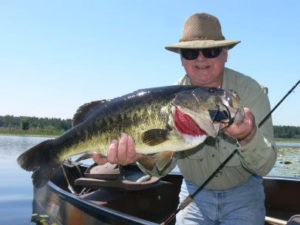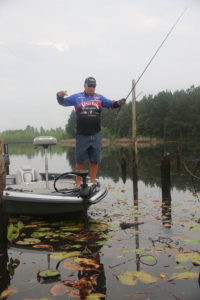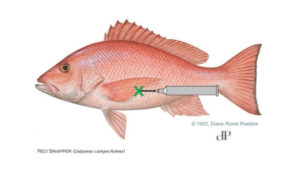Jackson Lake June Bass with Mike York
The bass at Jackson Lake are moving off their spawning areas and stacking up on summer time holes in June You can go to Jackson and catch a bunch of bass sitting on one hole when you find the right spot. They are hungry, hitting good and have not moved real deep yet.
Although Jackson is a fairly small lake it has very varied structure and cover. Fed by three main rivers and several creeks, it is full of main river and creek points that are magnets to bass after the spawn. Many have log jams, brush piles and rock cover that are perfect hiding spots for bass.
Recently the population of spotted bass at Jackson has exploded and those aggressive fish can be found in the same places as largemouth. Although the smaller spots may have replaced bigger largemouth, they seem to cooperate better with fishermen and give a great fight.
If there is a drawback at Jackson this time of year, it is the boat traffic. During the day it can be almost impossible to sit on a main lake point and fish. Skidoos will buzz you and bigger boats with skiers also ignore state law and will sometimes even run between you and the bank you are fishing. Go early in the morning or during the week if possible.
Mike York lives in Jackson and works for the Butts County Sheriff’s Department. Although he has been fishing all his life, he has been fishing with the Butts Bass Busters Bass Club for the past three years and made the state team last year at the Top Six. This year he finished 24 at the Top Six. He also qualified for the Stratos National Championships by finishing 24th in the state tournament.
This year Mike is also fishing the BFL and Everstart trails when possible. He catches a lot of bass and knows most Georgia lakes well, but knows Jackson better than others. He fishes a lot of the Berry’s Boat Dock night tournaments as well as their trail, and does well at Jackson, especially after the bass move out to the summer patterns.
Mike took me to Jackson in mid May to show me some patterns and places to fish for June bass. Due to the strange weather we have had this year, bass were still bedding in the middle of May and we saw many fresh beds. There were some bass on their summer holes already, and we caught about 8 or 9 fish off one spot that day.
This is Mike’s favorite time of year to fish for bass. They are settling down off their post spawn pattern and becoming more consistent in their behavior. For June fishing Mike looks for main lake points that drop into deep water. If they are on the outside bend of the creeks or rivers, they are even better. But the key is shallow feeding areas that drop fast into deep water.
He expects to find fish feeding in 12 to 16 feet of water in June, and concentrates on this range of depth. The bass will be a little more shallow the first of the month, moving deep as the water gets hotter.
Early each morning Mike will start with a top water plug like a Pop-R and a Zoom Fluke and fish it till the sun gets up. Topwater baits will catch fish that have been up feeding shallow at night, as well as bass that are still in a post spawn pattern. Not only can you move fast and cover a lot of water, getting bites on a top water plug is exciting.
Seawalls on points near deep water are good top water spots. Mike will cast right against the wall and fish the bait back out to the boat. Wood, riprap and concrete walls are all good. If you see bait fish flipping around them, they are even better. Seawalls in the area of the lake where Tussahaw Creek and the Alcovy River come together are the best.
After the sun is high, Mike moves out onto the points and throws crankbaits and Carolina rigs. He likes the Mann’s 15+ and Norman’s DD-22Ns with chartreuse sides and a blue back or the blue back with white or pearl sides.
On his Carolina rig Mike will stick with a half-ounce sinker if the wind and current will allow, going to a ¾ ounce only if necessary. Mike likes a lighter sinker and says he hardly ever fishes a one ounce sinker. He ties a 2 ½ to 3 ½ foot leader and uses a 1/0 or 2/0 hook in a Zoom Trick or Finesse worm. Junebug and green pumpkin are his favorite colors in both baits.
The following 11 places at Jackson are some of Mike’s favorite June holes. They will hold fish and give you an idea of the kinds of spots Mike looks for this month. You can check them out then use the information here to find many others like them.
1. This point was called “Snoopy’s Point” for many years because of the cutout of Snoopy on the bank. After you leave the island at Martin’s Marina, it is the upstream point of the third big cove on the right going upstream. The cove itself has two jug lines across its mouth, and the point has some big rocks on it.
Running off this point there is a ridge that runs out downstream and comes up to 17 feet deep on top well out from the bank. You want to locate this high spot and fish all around it, casting across it with both crankbait and Carolina rig from all directions.
There are big rocks under the water here and bass will hold on them. Start with your big crankbait since you can fish faster then come back with a Carolina rig. If there is any current or wind blowing across the point, make extra casts that move your bait with the current and wind since bass will relate to the moving water.
2. Straight across the lake you will see a small cove with a point on the upstream side. There are two big dead pines on the point and one leans to the left when you are facing the point. There is a wooden sea wall here with a small gap and beach on the upstream side of the point.
There are some rocks and stumps on this point. You can see some of the rocks up real shallow and more run out from them, as well as another group out from the edge of the beach. Stay out from this point and cast in toward it, fishing a crankbait and Carolina rig all around the rocks and stumps.
Then work up the bank toward the overhanging trees. There are more rocks under the water where the seawall dips in and trees hang over it. Fish them good. We caught our first keeper here and it was a spot. Mike says fish this place several times during the day since bass move in to feed at all times.
3. Head up the river and go into Tillman’s Cove, the creek that enters on the right just before the lake narrows down. The left bank will curve but have no pockets until you get about half way back. There are no houses or docks on it. Stop when you pass the first pocket. There are three points to fish here, the one on the upstream side of the first pocket, the one on the upstream side of the second pocket and the one directly across the creek from them.
Keep your boat out from the bank and cast toward the point. Bass hold in 10 to 12 feet of water on these points, especially early this month. Fish your crankbaits and Carolina rigs from the bank out to that depth, probing for stumps and brush.
4. Run up to where Tussahaw Creek splits off from the river and go the big point between them. On the creek side, look for a brown house with a stone chimney in the middle of the front of it. Out from the dock in front of that house a ridge runs out toward the creek channel. There are old logs and trash that has washed up on it and become waterlogged.
Stay well out from the ridge and cast across if from all directions. Work with the current or wind if there is any. This spot is just upstream of the hump where the old state brush pile is located. You can fish it, too, but don’t get the two confused. The ridge is in closer to the bank and the hump more out toward the middle of the creek on the big flat.
5. Just downstream of the old Kersey’s Marina site the main point between the cove at the marina site and the creek to the left is a round sand point. For years there was a sail boat tied to the dock on this point and it was called “Sailboat Point.” The sailboat is gone now but there is a white boat shed with a red door on the point.
A ridge runs off the point at the boathouse across the creek toward the cabin with the red roof on the other side of Tussahaw Creek. There is some trash on this point right where it drops on the downstream side. Keep your boat out on the downstream side and cast across the drop from deep water to shallow. You will be casting toward the old marina site.
Fish Carolina rigs and crankbaits across the ridge, working them down until you hit the trash. You want your crankbait to just tip the tops of the brush but you can work your Carolina rig through it. The crankbait will catch more active fish but you should follow it up with the slower moving Carolina rig.
6. Above the bridge in Tussahaw Creek, the creek makes a sharp turn to the right and straight ahead a smaller creek enters. As you go into the mouth of this creek a yellow cabin on the left sits on a flat bank on your left. A ridge runs off this bank straight across the cove toward the point between the small creek and the Tussahaw Creek channel. There are two rock piles on this ridge.
Line up the light pole in the yard of the yellow cabin with the right edge of the cabin and go straight out. When you are about even with the middle of the bridge, you are near one of the rock piles. You can idle back and forth across the areas to get a good idea of the way the ridge runs across the cove. It is a good idea to mark it with buoys.
Fish a Carolina rig across this ridge to locate the rock and any brush that has been put out here. Then cast a crankbait to the best areas. Fish with the wind if it is blowing across the ridge, but cover it from both sides if there is no wind.
7. Come out of Tussahaw Creek and head up the Alcovy River. There is a fairly narrow gap as you start up the river then it opens up. On the right bank of the wide area, just upstream of a swimming area and boat ramp for Turtle Cove, there is a small cove.
You will see light gray double dock with a balcony on top on the left side of the small cove. On the right side of this cove is a big three story light brown house with lots of windows and to the right of it is a big brick house. Just to the right of the house behind the gray dock you can just see and old road bed coming down to the point. It runs out across the flat point that the dock sits on.
This big flat point with the road bed is a good spot to fish. There is chunk rock and stumps on it and Mike says it is a good big fish hole. Stay way out from the point and cast up onto it with a crankbait, and then do the same with a Carolina rig. Fish all around this point with both baits.
8. Head into the mouth of the South River and go around the big point/island on the right. There will be a steep rocky bank on your right. Where the big rocks are right on the water, look to your left and start idling toward the two story house with a big deck on top. There is a flag pole in the yard behind the dock and if you line it up with the middle pole of the balcony on the house, and head toward it, you will come up on a flat in the middle of the river.
Keep your boat in 20 to 22 feet of water in the old river channel and cast toward the house. The flat comes up to 7 feet deep on top and drops off fast. Cast a crankbait up onto the flat and fish it back toward deeper water. Work up the drop all along this area then get your boat up on the flat and cast a Carolina rig out from the flat and work it up the drop, from deep to shallow.
9. Go around the bend up the South River and stay to the left, avoiding the big shallow flat out from Walker Harris Marina. When you pass the danger marker closest to the left bank, there will be a point on your left on the downstream side of a big cove. On the point is a dock with a pontoon tied to it and a For Sale sign in the yard.
The river channel swings in by this point and there is a big log jam under the water. Mike keeps his boat about 100 feet off the bank just downstream of the dock and casts upstream parallel to the bank. You can run a crankbait down this edge of the drop and cover it at several different depths, then follow it with a Carolina rig.
We caught 8 or 9 small bass here in May just after lunch. Mike says this is often a good mid-day hole because of all the cover under the water, and bigger fish will be on it by now. I caught three bass on three casts and hung up and broke my Carolina rig. Mike caught 4 while I was re-tying and then caught one or two more. He also hooked the biggest fish of the day here, a 2 pound plus fish that jumped and threw the hook.
10. Head up the Alcovy River and you will see some power lines crossing the river. There is a curving bar that runs out under these power lines fronm the left bank and there is an old state brush pile and some rocks on it.
Sit half way between the second and third balls on the line on the downstream side of the group of lines and cast up onto the point with both Carolina rigs and crankbaits. Mike says he always works this spot from the upstream side, casting up onto the bar and working his baits deeper. If you fish out until your are under the third ball you will be at the state brush pile and Mike says you will stay hung up there. Fish back toward the bank from it and you will catch bass without losing all your tackle.
11. Mike showed me one more spot that is a little hard to find. It is a ridge with a hump on it in the middle of the river above the power lines. If you head up the river you will see a point on the right bank that points upstream. All the way across the river is a light green cabin with a white dock in front of it.
This hump comes up to 12 feet deep in the best spot. If you line up the edge of the dock with the edge of the cabin, you will be in the right area. Sit on top of the hump and cast toward the bridge with your Carolina rig, fishing deep to shallow with it. Fish your crankbait in the opposite direction, working it from the top of the hump back toward deeper water to be more effective with it.
Give these 11 spots a try using Mike’s methods. They work great and you can take the things you learn and find other spots that are just as good. Jackson is a good lake this month if you can fish it for the pleasure boaters. The bass are there waiting on you.


